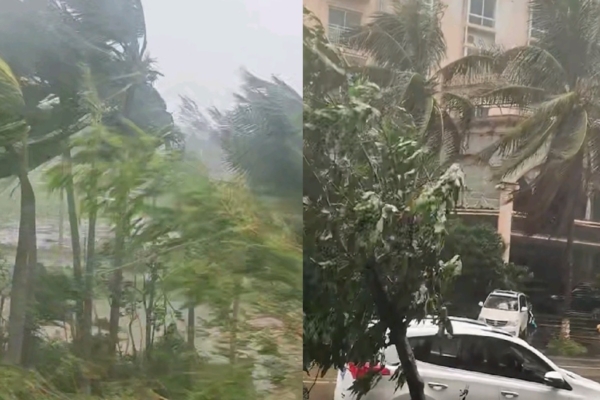On the afternoon of September 6th, Typhoon “Capricorn” (super typhoon category) made landfall in Wenchang, Hainan. Local residents reported that by noon on the 6th, water and power supply had been cut off, and the internet was also down. The strong winds in Wenchang blew away roofing sheets from houses and uprooted trees. The impact of the typhoon also reached Guangdong, with farmers in Zhanjiang lamenting the significant losses they have suffered.
According to the China Meteorological Administration, Typhoon “Capricorn” made landfall on the coastal areas of Wenchang, Hainan around 4:20 pm, with maximum sustained winds near the center reaching above 17 on the Beaufort scale (62 meters per second) and a minimum central pressure of 915 hPa.
Currently, most areas of Hainan Island are experiencing heavy rain, with some townships facing torrential rainfall.
It was reported that Typhoon “Capricorn” is the strongest autumn typhoon to land on the mainland.
Residents like Li Wenwen (pseudonym) in Wenchang shared that the situation was precarious before the typhoon hit. He mentioned to reporters that people couldn’t stand firm outside as trees in the neighborhood were all toppled by the strong winds. Communication signals were only somewhat available in the area through the telecommunications network, while mobile networks had completely failed.
Li Wenwen mentioned that the power went out around noon.
Another resident in Wenchang, Qian Fei (pseudonym), confirmed that there was no mobile signal, saying, “Even 5G has no signal.” He expressed concerns about the flooding inside the houses, feeling unsafe and unable to sleep. The glass on the ground floor was shattered, prompting worries about the glass on the upper floors being shattered as well.
Chen Chao (pseudonym) informed reporters that water and power supplies were cut off in the area. He felt the buildings vibrating and witnessed roofing sheets being blown off neighboring houses. “This piece of roofing was just blown off directly,” Chen Chao exclaimed, emphasizing the incredibly strong winds that seemed about to explode.
Residents such as Chen Li in Haikou, Hainan, shared their fear of being blown away when venturing outside due to the intense winds. The situation was so dire that windows couldn’t be opened as they were promptly blown away. “Even thin people are blown away when they go out,” said Chen Li, who hadn’t had the chance to prepare food and could only drink water.
Chen Li, residing in a high building, expressed concerns about the accumulating water levels, fearing that if it continued raining for another hour, the water might breach the roadside barriers.
Ke Xing (pseudonym), living near Wenchang, Hainan, described the terrifying experience of the typhoon, emphasizing the extreme danger of being outside as roofing sheets were on the verge of being ripped off from buildings.
Ke Xing shared that even the coconut trees on the streets were bent by the strong winds, with the roads already starting to flood.
The official website of the Hainan Meteorological Bureau issued warnings indicating a high potential for flash floods in parts of 14 cities and counties, including Haikou, Danzhou, Wenchang, Qionghai, Dongfang, and Wuzhishan.
The Hainan Provincial Meteorological Bureau predicted a high risk of rainfall-induced geological disasters in specific areas over the next 24 hours, with elevated risks warranting a level I warning (red alert).
The Hainan Province’s emergency response headquarters for Typhoon “Capricorn” reported as of 9 a.m. on September 6th that 418,275 people had been relocated in the province.
The impact of the typhoon extended to Guangdong, Guangxi, and other regions. The Guangdong Meteorological Department mentioned that if Typhoon “Capricorn” made landfall in Guangdong at super typhoon level, it would be the first super typhoon to hit Guangdong since 2015.
In Zhanjiang, Guangdong, farmers like Dong Min (pseudonym) expressed the destruction caused by the typhoon, with large trees being uprooted and significant losses on their banana and passion fruit crops.
“Both bananas and passion fruit are ruined,” Dong Min lamented. Reflecting on the devastation caused by previous typhoons, like the 17th-grade Typhoon “Meranti” in 2014, Dong Min recalled the damages incurred back then. Facing losses estimated at 5 to 6 thousand RMB due to this year’s typhoon, Dong Min highlighted the missed opportunity for profits as his banana harvest was nearing maturity with high market value. The news of the approaching typhoon left him restless, unable to eat or drink, experiencing sleepless nights.
————–
It seems the typhoon “Capricorn” has left a trail of destruction and fear, not only in Hainan but also in neighboring areas like Guangdong and Guangxi. The testimonies of the residents paint a picture of chaos and danger caused by the powerful winds and heavy rains. The authorities have issued warnings and implemented emergency measures to cope with the aftermath of the typhoon. The impact on agriculture and livelihoods underscores the vulnerability of communities in the face of such natural disasters.

